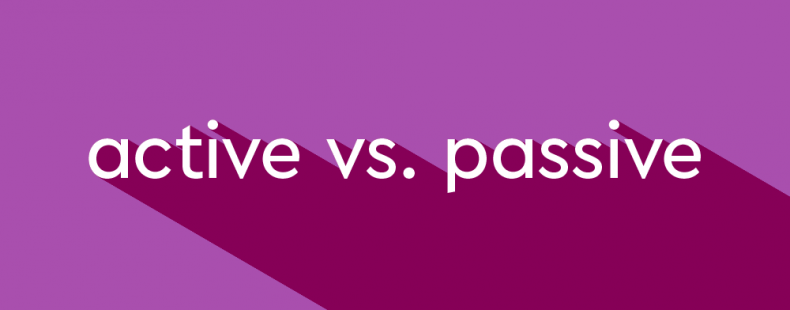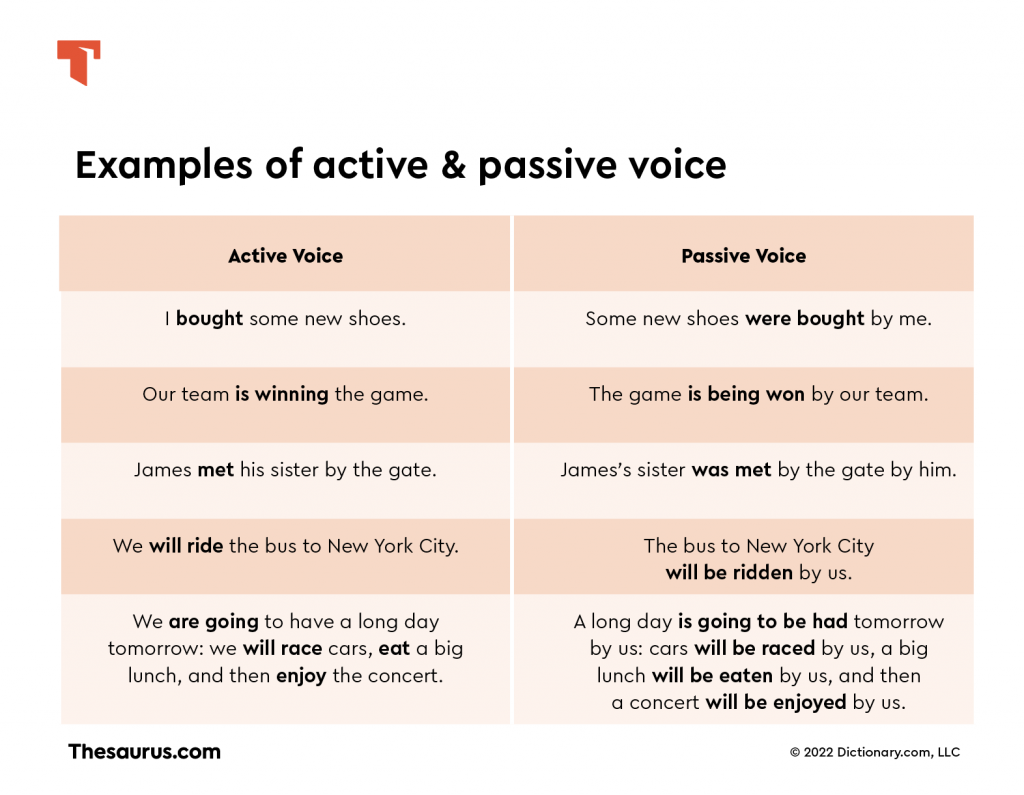WATCH: How Do You Fix Passive Voice In A Sentence?
In English, every sentence needs a verb. Verbs tell us what is happening or what someone or something is doing. As it happens, verbs generally come in two different “voices.” They are the active voice and the passive voice. The active voice tends to be more direct and appears in shorter sentences like We ate lunch. On the other hand, the passive voice tends to be more roundabout and appears in longer sentences like Lunch was eaten by us.
So how do we know which voice to use? Are they really all that different? Before we lose our voice asking lots of good questions, it is time we learned about the two voices that we use in writing and speech in English.
What is passive voice?
The passive voice is the voice used when a subject of a sentence or clause is acted on by the verb. In other words, the subject is having something done to it rather than doing something itself.
Take a look at this sentence:
- The sandwich was eaten by Jeremy.
As you probably know, the subject of this sentence is the sandwich. Reading the sentence, you know that the sandwich isn’t doing anything. Instead, Jeremy is the one doing something; he ate the sandwich. In this sentence, the subject is the receiver rather than the performer of the action. Since this is the case, this sentence uses the passive voice. In a manner of speaking, a sentence that uses the passive voice looks backwards because it seems as though the direct object (which typically receives an action) is the subject.
When used in a sentence or clause, the passive voice uses a basic structure. This is:
- [subject] + [the properly conjugated form of the verb be] + [past participle of a verb]
The verb be will be conjugated to adhere to subject-verb agreement and will be in the proper verb tense. In addition to this basic structure, the passive voice often uses a prepositional phrase beginning with the word by to identify who or what is performing an action to the subject. The phrase by Jeremy serves this purpose in our above example.
Read more in depth about the passive voice here.
Passive voice examples
All of the following examples demonstrate the passive voice being used in a variety of sentences.
- The survey is being completed by the entire school.
- Peter has been bitten by spiders on a regular basis.
- School will be canceled tomorrow.
- Arianna was chosen to be the leader of our club.
What is active voice?
The active voice is the voice used when the subject is doing something rather than having something done to it. For example, the sentence The monkey is eating a banana is a sentence that uses the active voice. In this sentence, the subject (the monkey) is the one doing the thing described by the verb (eating). Unlike the passive voice, a sentence that uses the active voice can also have a direct object that identifies who or what is receiving the action of the verb. Our example sentence has a direct object (a banana) that says what the monkey is eating.
In general, the active voice is the voice that is used much more often in academic and formal writing and speech. Even in casual speech and writing, it is usually the voice that comes most naturally to speakers and writers.
There is no special structure or special rules when it comes to using the active voice. The active voice follows the basic sentence structure of a subject followed by a verb as in Birds fly. Of course, any verb used in the active voice must follow subject-verb agreement so that the sentence is grammatically correct.
Dive even deeper into the active voice here.
Active voice examples
The following sentences all use the active voice. You’ll notice that in each one the subject is the one performing the action described by the verb.
- The pitcher threw the baseball.
- Pandas eat bamboo.
- The children are sleeping.
- We will go to the beach when it stops raining.
Passive vs. active voice comparison
Let’s compare the passive and active voices by looking at how they can be used in sentences. In the following list, each pair of sentences expresses the same meaning with the first using the active voice and the second using the passive voice.
- Active: I bought some new shoes.
- Passive: Some new shoes were bought by me.
- Active: Our team is winning the game.
- Passive: The game is being won by our team.
- Active: James met his sister by the gate.
- Passive: James’s sister was met by the gate by him.
- Active: We will ride the bus to New York City.
- Passive: The bus to New York City will be ridden by us.
- Active: We are going to have a long day tomorrow: we will race cars, eat a big lunch, and then enjoy the concert.
- Passive: A long day is going to be had tomorrow by us: cars will be raced by us, a big lunch will be eaten by us, and then a concert will be enjoyed by us.
However, there are some instances where you may decide that the passive voice is best. Some examples include:
- When avoiding assigning blame: The toy was broken vs. Nathan broke the toy.
- When the performer of an action is unknown, unimportant, or obvious: The suspect was arrested this morning. (Obviously, the police arrested the suspect)
- When it is obvious who is performing the action: 50g of magnesium was added to the compound. Scientific papers will often use the passive voice because it is obvious that scientists or researchers are the ones performing actions.
- When shifting the focus of a sentence: The pyramids were built by the ancient Egyptians vs. The ancient Egyptians built the pyramids.
- When a subject does something and has something done to it at the same time: The talkative parrots entertained the guests and were fed crackers by their handlers.
Here’s a helpful tip: intransitive verbs mainly use the active voice. The reason why makes sense if you think about what intransitive verbs are. They are verbs that show complete actions but are not accompanied by a direct object or form a passive. (Remember that many verbs have both transitive and intransitive senses.) This might be easier to understand with some examples.
The following two sentences show intransitive verbs used in the active and passive voice. The first sentence is grammatically correct while the second sentence is absurd and doesn’t make any sense.
- Active: The flowers are blossoming.
- Passive: The flowers are being blossomed.
Review the different verb tenses so you can identify passive and active voice in each of them.
Passive voice misuse
In general, it is a good idea to use the active voice unless you have a good reason to use the passive voice instead. Misusing or overusing the passive voice will often lead to sloppy writing or grammar errors that will confuse or annoy listeners or readers. In most cases, it is a good idea to double check your writing. Often, any passive voice sentences can be replaced with shorter, clearer active voice sentences.
How to fix passive voice
Most of the time, it is relatively simple to change a passive voice sentence into an active voice sentence. In order to do it, there are three simple steps:
- Identify who or what is actually performing the action described by the verb in the sentence. This will become the subject of our active voice sentence.
- Get rid of the verb be and turn the past participle into a correctly conjugated verb. This new verb must agree with our new subject.
- Take the subject of the old sentence and turn it into a direct object.
That’s all there is to it! Keep in mind that the new sentence must have the same meaning as the old one.
Let’s put these steps into practice by turning a passive voice sentence into an active voice sentence. Here is our example sentence:
- The cake was eaten by the girls.
Let’s use our steps:
- Who or what is doing something? The answer is the girls. The girls are the ones who are performing an action (eating). So, the girls will be the subject of our new sentence.
- We get rid of the verb be (was) and turn the past participle (eaten) into a verb tense that expresses the same meaning as the original sentence. In this case, the simple past tense verb ate is a good choice.
- We take our old subject (the cake) and turn it into a direct object.
Our new sentence becomes:
- The girls ate the cake.
This sentence uses the active voice and is a little shorter and easier to read, too.
Before you go fixing every passive voice sentence, make sure the sentence you want to fix is actually in the passive voice. Sometimes, a sentence seems to use passive voice when it actually doesn’t. For example, take a look at the following sentence:
- The director was pleased when he saw the actors’ performance.
Although this sentence looks like it uses the passive voice, it doesn’t. In this sentence, pleased is acting as an adjective and was is used as a linking verb. Because past participles can be used either to make the passive voice or as adjectives, it is important to read a sentence carefully to identify the true purpose of the past participle.
Make an active choice to improve your grammar
Confused about passive voice and its proper use? Let Thesaurus.com Grammar Coach™ guide you! This writing platform uses machine learning technology uniquely designed to catch grammar as well as spelling errors. Plus, Grammar Coach™ Synonym Swap will find the best nouns, adjectives, and more to help say what you really mean, guiding you toward clearer, stronger, writing.















